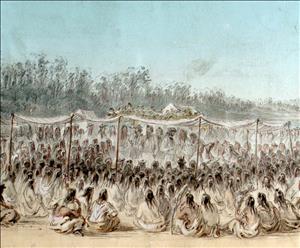On May 29, 1855, Washington Territorial Governor Isaac Stevens (1818-1862) convenes the First Walla Walla Council with tribes of the Columbia River basin. Stevens meets with representatives of the Yakama, Nez Perce, Walla Walla, Umatilla, and Cayuse at an old council ground at Mill Creek near the Walla Walla River. The Palouse decline to participate. Stevens's orders are to extinguish the tribes' title to lands in the territory in order to open it for settlement. Some 5,000 Native Americans are present. Stevens offers the tribes reservations, cash, and especially, the right to retain their ancient and traditional hunting and fishing grounds.
Context of the Council
Following the 1847 Whitman Massacre and the subsequent defeat of the Cayuse Tribe, which was blamed for the violence, the Cayuse continued to encourage other Native American groups to resist the invasion of their ancestral lands. Their concerns were shared by other regional tribes, including the Walla Wallas, the Palouses, the Umatillas, the Spokanes, and the Yakamas. The Nez Perce felt somewhat less threatened due to their perceived isolation; this would change in future years.
The year 1853 saw the organization of Washington Territory and the subsequent arrival, in Olympia, of newly appointed territorial governor Isaac Ingalls Stevens. He had been instructed not only to establish territorial government, but to serve as Superintendent of Indian Affairs, and to conduct explorations to determine a route for a future cross-continental railroad. Stevens saw his role of Indian Superintendent as an effort to extinguish Indian entitlement to their land and their removal to designated reserves in order to clear the territory for the expected waves of white American settlers.
His method for accomplishing this was to organize a series of councils, meeting with individual tribes, in groups, to try to convince them to sign treaties that essentially divested them of most of their ancestral lands. To do so, Stevens used a combination of promised gifts and threats of force. Additionally, he applied the art of deception and took advantage of divisions among the various tribes.
Tensions and Divisions
The first Walla Walla treaty council took place near present day Walla Walla in the late spring of 1855. Tensions were high, for the tribes sensed what was to take place. Opposition to treaties was greatest among the Cayuses, Walla Wallas, and Yakamas. A chief of the latter group, Kamiakin (ca. 1800-1877), was a lead instigator in focusing Native American resistance to surrender of their lands. The Walla Walla chief, Peo-Peo-Mox-Mox (1800?-1855), was another leader who was extremely concerned. The Nez Perce, also present at the council, were divided, with chief Lawyer essentially in favor of a treaty, and another chief, Looking Glass, opposed.
Some of the angrier groups proposed to attack the territorial party and eject the whites from the land. Cooler heads prevailed and, over the course of several days, the Indians listened to Stevens’ proposals. He promised gifts and the retention of their ancient hunting and fishing rights, in their traditional places, in exchange for the loss of most of their homelands and removal to reservations. The Indians were fearful and requested a delay, but Stevens would not permit it.
By June 11, 1855, all had signed the treaties, even the bitter chiefs Kamiakin and Peo-Peo-Mox-Mox. The reasons for this probably were a combination of resignation, intimidation, and hope. Of all the gifts and money granted, transitory things, it was the promise of retaining their traditional hunting and fishing rights that is the only provision of the treaty that the tribes still value to this day, and are still occasionally debated in modern courtrooms.

